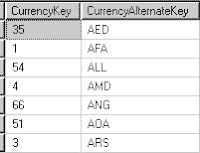Lookup:Exact MatchDatabase: AdventureWorksDW
Reference Tables: dbo.DimTime and dbo.DimCurrency
SELECT TimeKey,FullDateALternateKey FROM DimTime

SELECT CurrencyKey,CurrencyAlternateKey FROM DimCurrency
Flat File: sample.txt
1.00050025;AED;9/7/2001 0:00;0.99990001
1.00050024;AED;9/8/2001 0:00;1.001001001
1.00030025;AED;9/9/2001 0:00;1
1.00010001;AED;9/10/2001 0:00;1.00040016
1.00020004;AED;9/11/2001 0:00;0.99980801
1.00050001;AED;9/12/2001 0:00;1.001101211
Data in sample.txt file will be transformed. The transformation references two tables:DimTime and DimCurrency.
BIDS--Create an SSIS project
Drag "Data Flow Task" onto Control Flow pane;
Double Click "Data Flow Task" to navigate to Data Flow pane;
 "Flat File Source"
"Flat File Source" File Name=C:\sample.txt and create the advanced mapping as:
- Column 0 --AverageRate --numeric [DT_NUMERIC], Data Precision:18 and DataScale:8
- Column 1--CurrencyAlternateKey--Unicode text stream [DT_WSTR], OutputWidth:3
- Column 2--FullDateAlternateKey--database timestamp [DT_DBTIMESTAMP]
- Column 3 --EndOfDayRate--numeric [DT_NUMERIC], Data Precision:18 and DataScale:8
"Lookup" transformation item
Connection to dbo.DimCurrency of AdventureWorksDW database;

Make sure you tick the CurrencyKey in the Available Lookup Columns. OK. Save it.
"Lookup 1 control" Connection to dbo.DimTime of AdventureWorksDW database;

Make sure you tick the TimeKey column.
"Flat File Destination"New Flat File Connection Manager: File Name C:\outputFile.txt
 Save the package and execute it;
Save the package and execute it;
The c:\outputFile.txt will have:
1.00050025,.9999000100,35,69
1.00050024,1.0010010010,35,70
1.00030025,1.0000000000,35,71
1.00010001,1.0004001600,35,72
1.00020004,.9998080100,35,73
1.00050001,1.0011012110,35,74
====
data cleansing
Flat File:sample1.txt
1.00010001;AED;7/3/2001 1:00;0.99960016
1.00010001;AEC;7/4/2001 0:00;1.00100100
1.00020004;AFB;7/5/2001 2:00;0.99990001
1.00020002;ALL;7/6/2001 0:00;1.00040015
1.00050025;ALL;7/7/2001 4:00;0.99990001
1.00050024;ALH;7/8/2001 2:00;1.001001001
1.00030025;AND;7/9/2001 0:00;1
1.00010001;AND;7/10/2001 5:00;1.00040016
1.00020004;AMD;7/11/2001 1:00;0.99980801
1.00050001;AMD;7/12/2001 0:00;1.00110121
AED and AEC are not in the dbo.DimCurrency. Similarly, the time (in red) is not in dbo.DimTime table.
If you apply the sample1.txt to the above package, it fails with the error message:
Information: 0x402090DD at Data Flow Task, Flat File Source [1]: The processing of file "C:\sample1.txt" has ended.
Information: 0x402090DD at Data Flow Task, Flat File Destination [745]: The processing of file "D:\AOL\outputFile.txt" has ended.
Information: 0x40043009 at Data Flow Task, DTS.Pipeline: Cleanup phase is beginning.
Information: 0x4004300B at Data Flow Task, DTS.Pipeline: "component "Flat File Destination" (745)" wrote 0 rows.
 C:\Windows\system32>bcdedit /displayorder {ntldr} /addlast
C:\Windows\system32>bcdedit /displayorder {ntldr} /addlast




 If you encrypt your triggers, they are not copied to the subscribers.
If you encrypt your triggers, they are not copied to the subscribers.
 Fuzzy Grouping:
Fuzzy Grouping: As seen, select the fuzzy criteria: Title, FirstName,LastName, and EmailAddress. Similarity Threshold: 0.8
As seen, select the fuzzy criteria: Title, FirstName,LastName, and EmailAddress. Similarity Threshold: 0.8 Input and output mapping:
Input and output mapping:


 Column 0 --AverageRate --numeric [DT_NUMERIC], Data Precision:18 and DataScale:8
Column 0 --AverageRate --numeric [DT_NUMERIC], Data Precision:18 and DataScale:8





 Make sure you tick the CurrencyKey in the Available Lookup Columns. OK. Save it.
Make sure you tick the CurrencyKey in the Available Lookup Columns. OK. Save it. Make sure you tick the TimeKey column.
Make sure you tick the TimeKey column. Save the package and execute it;
Save the package and execute it; Double_click P_SQL.dtsx;
Double_click P_SQL.dtsx; 





 Save the S_SQL.dtsx package;
Save the S_SQL.dtsx package;




 Open the dbo.[SSIS Configurations] table, identify the row with Configuration Filter set to example1, modify the configuredValue, and rerun the package:
Open the dbo.[SSIS Configurations] table, identify the row with Configuration Filter set to example1, modify the configuredValue, and rerun the package: 
 Create an SSIS project;
Create an SSIS project;
 After the configuration, value of environment variable ConnectStr will replace the ConnectionString target property; The value of environment variable MyFile will replace the Arguments of Execute Process Task.
After the configuration, value of environment variable ConnectStr will replace the ConnectionString target property; The value of environment variable MyFile will replace the Arguments of Execute Process Task.
 Connection to AOL Folder manager will access the c:\sample1.txt, sample2.txt, etc.
Connection to AOL Folder manager will access the c:\sample1.txt, sample2.txt, etc.

 Double-click on Flat File Source and make sure that the column names are correctly mapped. And then, double-click on the OLE DB Destination, click on the Mapping, you should have the following:
Double-click on Flat File Source and make sure that the column names are correctly mapped. And then, double-click on the OLE DB Destination, click on the Mapping, you should have the following: Execute the package;
Execute the package; Double-click the Lesson 2.dtsx package;
Double-click the Lesson 2.dtsx package;

 Select "Connection to AOL Folder", Properties pane:
Select "Connection to AOL Folder", Properties pane: